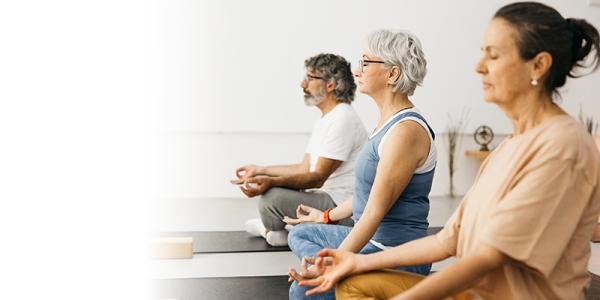
In this article:
- Yoga offers physical benefits such as improved flexibility, strength, and balance, which can help prevent injuries and support overall health.
- Practicing yoga can reduce stress, promote relaxation, and enhance mental well-being through mindful breathing and meditation techniques.
- Yoga is accessible to people of all ages and fitness levels, and even simple poses or short sessions can provide meaningful health benefits.
What do the San Francisco Giants team and the Alvin Ailey dancers have in common? What about Halle Berry and Lady Gaga, or Sting and Adam Levine? One word: yoga. From athletes, dancers, and entertainers to health-minded individuals from all walks of life, more and more people are practicing yoga for its physical, mental, and emotional health benefits.
What Can Yoga Do for You?
Yoga is a unique form of exercise that strengthens the mind-body connection. It can be adapted for people of all ages and physical ability. Organizations such as the U.S. military, the National Institutes of Health, Google, and JP Morgan are making the practice available to their members and employees. Yoga helps:
- Improve balance and flexibility, reducing stiffness so you can move more comfortably and fluidly.
- Build strength, especially in the core, arms, legs, and back.
- Refine coordination and proprioception, the awareness of where your body is in space.
- Help speed healing after an illness, accident, or surgery.
- Manage ongoing issues and conditions such as osteopenia, headaches, cancer, women’s pelvic issues, and chronic pain.
- Provide back pain relief and improve mobility, so much so that the American College of Physicians recommends yoga as a first-line treatment for low back pain.
- Lessen arthritis pain. People with arthritis are usually told to walk, swim, or bike but yoga has the added benefits of building flexibility, strength, and balance.
- Promote heart health and lower blood pressure. The slow movements and deep breathing that characterize Hatha yoga stimulate blood flow and reduce inflammation. More energetic types of yoga improve heart rate and circulation and can help facilitate weight loss.
- Support healthy sleep by calming the nervous system, relaxing you physically and mentally so you are more likely to fall asleep and stay asleep.
- Boost your mental and physical energy and brighten your moods.
- Lower levels of the stress hormone cortisol and increase levels of serotonin to help reduce stress, anxiety, and depression and support mindfulness and positivity.
- Improve focus and mental clarity when the practice includes mindfulness.
- Correct postural issues with regular practice.
- Improve lung capacity and oxygenation through traditional breathing exercises.
Choosing the Type of Yoga That Fits Your Needs
Yoga was developed in India several thousand years ago to promote physical, mental, emotional, and spiritual wellbeing. While we tend to think of yoga as a form of exercise, the practice may also include chant, meditation, breathing exercises, and repeating spiritual phrases called mantras. There are different schools of yoga and it’s a good idea to shop around before you settle on a studio.
Hatha Yoga is the basis of all yoga, encompassing all the physical poses. Generally, studios that define themselves as Hatha will offer a range of classes that accommodate both beginners and seasoned yogis. While all the types of yoga listed below are grounded in the Hatha tradition, they can vary greatly in intensity and pace.
Yoga for Exercise and Strength
Vinyasa Yoga, the most common type of yoga in the US, emphasizes choreography and flowing movements that are synchronized with breath. While providing a good workout, the flow also has a grounding, meditative effect.
Ashtanga Yoga is a precise, physically demanding workout that keeps you moving constantly. Regardless of who is teaching, poses are done in the same sequence, which you are expected to know. This practice is best for healthy, athletic people who are already familiar with yoga.
Bikram Yoga has you perform the same sequence of 26 set poses twice, in a room heated to 105 degrees and 40 percent humidity. If you enjoy variety and/or don’t like heat, Bikram is not your jam.
Kundalini Yoga is an intense practice with a strong spiritual component. It aims to release the vital life force, or “kundalini energy” which practitioners believe resides at the base of the lower spine. Classes combine a powerful core-based workout with chanting, mantra, and meditation.
Yoga for Relaxation, Alignment and Stress Reduction
Yin Yoga is a slow, relaxing practice that targets the fascia -- connective tissues that hold our muscles together -- to improve flexibility and stimulate circulation. Poses are held for at least a minute and often use props such as bolsters, blocks, and blankets.
Iyengar Yoga focuses on proper alignment and longer holds with the help of bolsters, blocks, straps, blankets, walls, and even chairs and benches. This practice moves slowly, and the poses focus on proper alignment and longer holds, making it suitable for people of all ages and skill levels.
Prenatal Yoga emphasizes breathing techniques and minimizes the aches and pains of pregnancy.
Restorative Yoga, the most relaxing of the practices described here, focuses on stress reduction. You can expect to be lying down for the duration of class. Props are used to help you sink into the poses, which are held for at least five minutes.
Hybrid Forms of Yoga
Chair Yoga is a gentle adaptation of Hatha Yoga that can be done seated in a chair. It is ideal for beginners, seniors, people with certain disabilities, and those recovering from illness or surgery.
Strength Yoga was once a term people used interchangeably with Power Yoga to describe a physically demanding flow. In recent years, some studios have started offering “Strength Yoga” classes that mix yoga poses with weights for a full body workout.
Aerial Yoga combines traditional yoga poses, Pilates, and dance with the use of a hammock-like sling suspended from the ceiling. Certain challenging yoga postures are easier to perform through aerial yoga.
If you’re unfamiliar with yoga or find the idea intimidating, it’s important to find a supportive class that focuses on teaching beginners the basics. From there, you can branch out to find the style and pace that best fit your needs. And don’t give up too soon; as with anything new and different, consistency is the key to getting the results you need!
This article first appeared in the October 2025 edition of the HealthPerks newsletter.

